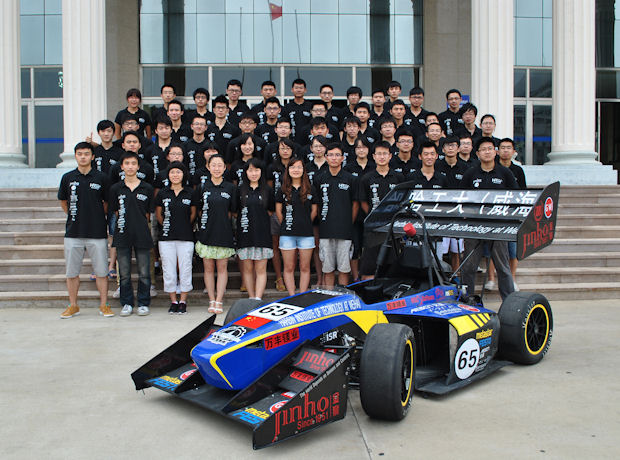
Harbin Institute of Technology racing team and car.
Latest News
January 1, 2015
By Hao Yuzhou
 Harbin Institute of Technology racing team and car.
Harbin Institute of Technology racing team and car.The Harbin Institute of Technology (HIT) racing team is very familiar with the use of simulation for automotive design. The team has participated in Formula Student Germany and Formula Student Japan; it received second prize for Formula Student China in 2013. ANSYS software has been instrumental in designing many aspects of the team’s lightweight vehicle, including the unique carbon-fiber monocoque, aerodynamics and the intake system. Of the 58 members on the team, 30 use ANSYS tools to achieve their individual design goals by employing ANSYS Mechanical, ANSYS Fluent, ANSYS Composite PrepPost, ANSYS DesignXplorer and ANSYS LS-DYNA.
 Maximum total deformation simulation was used to obtain torsional stiff ness for the monocoque vehicle body, an important factor in its performance.
Maximum total deformation simulation was used to obtain torsional stiff ness for the monocoque vehicle body, an important factor in its performance.The team overcame design challenges using parametric simulation and optimization. The students perform parameterization using ANSYS DesignXplorer to create a faster car that is also powerful, lightweight and reliable. Multiphysics capabilities accessed through ANSYS Workbench allowed HIT team members to develop models that closely matched real world conditions.
The HIT team used ANSYS Composite PrepPost to simulate the stiffness of the vehicle’s monocoque to reduce the weight of the layered composite body. Team members combined experiments with ANSYS simulation to develop the composites material. The intuitive interface of Composite PrepPost efficiently defined the materials, plies and stacking sequences; it also offered a wide choice of state-of-the-art failure criteria. ANSYS solvers provided the foundation for accurate results, and data from physical testing was consistent with the analyses. The software helped the team to improve the stiffness of the chassis and reduce local stress concentrations. The final monocoque weighed 18.4 kg (40.6 lbs), which is 2.6 kg (5.7 lbs) lighter than the previous version. The team also achieved a 14% improvement in the stiffness-to-weight ratio.
 Fluid–structure interaction simulation of air intake. The team needed to find a design that would deform less than 0.5 mm under negative pressure so that the air flow would not be influenced.
Fluid–structure interaction simulation of air intake. The team needed to find a design that would deform less than 0.5 mm under negative pressure so that the air flow would not be influenced.The air intake for the vehicle was designed with the help of fluid–structure interaction (FSI) that combined Fluent with ANSYS Mechanical software. The intake system for the engine experiences negative pressure during operation. By collecting manifold pressure sensor data, the HIT team found that the peak negative pressure is 0.7 bar in the intake manifold. This level of negative pressure can change the shape of the air intake system, which, in turn, influences the flow field inside the manifold and can even destroy the structure of the air intake.
Since the team uses carbon-fiber composites material for the air intake system, FSI system analysis was used to ensure overall stiffness, weight reduction and optimization of the layer design.
This pervasive use of simulation was enabled through formal training by ANSYS that allowed the team to begin simulation early in the design process. In addition, team members who were experienced with simulation worked with an expert ANSYS engineer to develop best practices. The team found that ANSYS Workbench was easy to learn for new users, and provided good mesh control along with accurate simulation results.
 Every year, students around the world use simulation in engineering competitions that are not only fun but prepare them for future careers.
Every year, students around the world use simulation in engineering competitions that are not only fun but prepare them for future careers.Using engineering simulation gave the team the ability to explore many designs and manufacture only the best one. For future competition vehicles, the HIT racing team will need to conduct further simulations, so they plan to train even more team members in the use of ANSYS software and employ additional modules to conduct coupled simulations.
Hao Yuzhou is involved in chassis design and finite element analysis for the HIT Racing Team, Harbin Institute of Technology, Weihai, China. This article originally appeared in ANSYS Advantage magazine, Vol. VIII, Issue I, 2014.
More Info
Subscribe to our FREE magazine, FREE email newsletters or both!
Latest News







